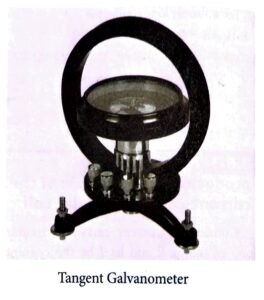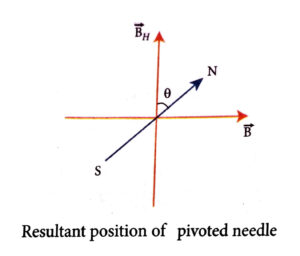Tangent galvanometer is a device used to detect very small currents. It is a moving magnet type galvanometer. Its working is based on tangent law

Tangent law
When a magnetic needle or magnet is freely suspended in two mutually perpendicular uniform magnetic fields, it will come to rest in the direction of the resultant of the two fields.
Let B be the magnetic field produced by passing current through the coil of the tangent galvanometer and BH be the horizontal component of Earth’s magnetic field. Under the action of two magnetic fields, the needle comes to rest making angle θ with BH, such that
B = BH tan θ
Construction
Tangent Galvanometer (TG) consists of copper coil of several turns wound on a non-magnetic circular frame. The frame is made up of brass or wood which is mounted vertically on a horizontal base table (turn table) with three levelling screws. The TG is provided with two or more coils of different number of turns. Most of the equipments we use in laboratory, contains coils of 2 turns, 5 turns and 50 turns which are of different thickness and are used for measuring currents of different strengths.
At the centre of turn table, there is a small upright projection on which a compass box is placed. Compass box consists of a small magnetic needle which is pivoted at its centre, such that the centres of both magnetic needle and circular coil exactly coincide. A thin aluminium pointer attached perpendicular to the magnetic needle moves over a graducated circular scale. The circular scale is divided into four quadrants and they are graduated in degrees, each quadrant being numbered from 0° to 90° In order to avoid parallax error in measurement, a mirror is placed below the aluminium pointer.
Precautions
- All the nearby magnets and magnetic materials are kept away from the instrument.
- Using spirit level, the levelling screws at the base are adjusted so that the small magnetic needle is exactly horizontal and also coil (mounted on the frame) is exactly vertical.
- The plane of the coil is kept parallel to the small magnetic needle by rotating the coil about its vertical axis. So that, the coil remains in magnetic meridian.
- The compass box alone is rotated such that the aluminium pointer reads 0° – 0°.
Theory
In the tangent galvanometer experiment, when no current is passed through the coil, the small magnetic needle lies along horizontal component of Earth’s magnetic field. When the circuit is closed, the electric current will pass through the circular coil and produce magnetic field at the centre of the coil. Now there are two fields which are acting mutually perpendicular to each other.
They are:
(1) the magnetic field (B) due to the electric current in the coil acting normal to the plane of the coil.
(2) the horizontal component of Earth’s magnetic field (BH)

Because of these crossed fields, the pivoted magnetic needle deflects through an angle θ. From tangent law,
B = BH tan θ
When an electric current is passed through a circular coil of radius R having N turns, the magnitude of magnetic field at the centre is


The horizontal component of Earth’s magnetic field is given by

| Read More Topics |
| Electrostatics – Van de Graaff Generator |
| Lightning arrester or lightning conductor |
| Architectural acoustics |





